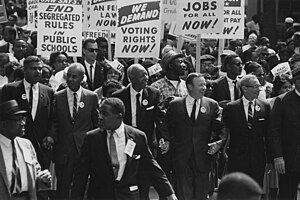The Civil Rights Movement: A Fight for Justice and Equality
The Civil Rights Movement was a defining period in American history, spanning from 1954 to 1968. This movement aimed to abolish legalized racial segregation, discrimination, and disenfranchisement in the United States. Key events such as the Montgomery Bus Boycott in 1955, the March on Washington in 1963, and the Selma to Montgomery marches in 1965 galvanized public opinion and led to landmark legislation. The motives were clear: to secure equal protection under the law and to end the systemic racism that had long plagued the nation.
 Source: Wikimedia Commons
Source: Wikimedia Commons
Several key figures emerged during this era, including Martin Luther King Jr., Rosa Parks, and Malcolm X. Martin Luther King Jr.'s philosophy of nonviolent resistance inspired many, and his "I Have a Dream" speech remains iconic. Rosa Parks' refusal to give up her bus seat sparked the Montgomery Bus Boycott, a pivotal moment in the fight against segregation. Malcolm X advocated for black empowerment and self-sufficiency, providing a different perspective on achieving equality.
The movement's major victories include the Civil Rights Act of 1964 and the Voting Rights Act of 1965. These laws dismantled legal segregation and protected voting rights, respectively. Despite these achievements, the struggle was fraught with violence, including the assassination of Martin Luther King Jr. in 1968. His death underscored the deep-seated resistance to racial equality but also paved the way for continued activism.
The Civil Rights Movement was not just a series of protests but a comprehensive social revolution. It involved grassroots activism, legal challenges, and significant public demonstrations. The movement fundamentally changed American society, laying the groundwork for future generations to continue the fight for justice and equality. Its legacy is a testament to the power of collective action in achieving monumental social change.

.png?alt=media&token=02bfc738-437e-4172-95a3-4f1923b87293)